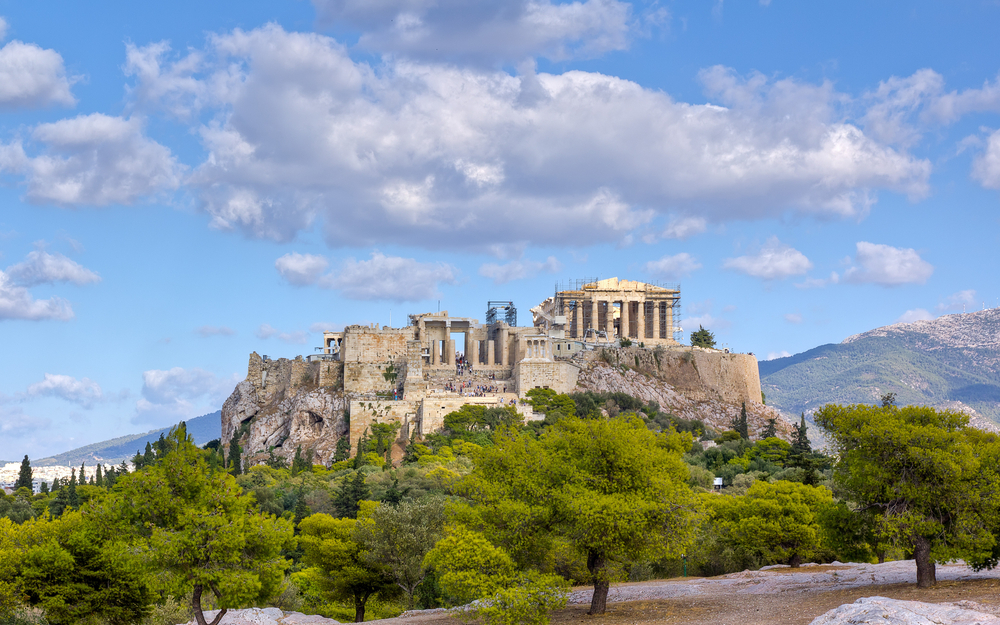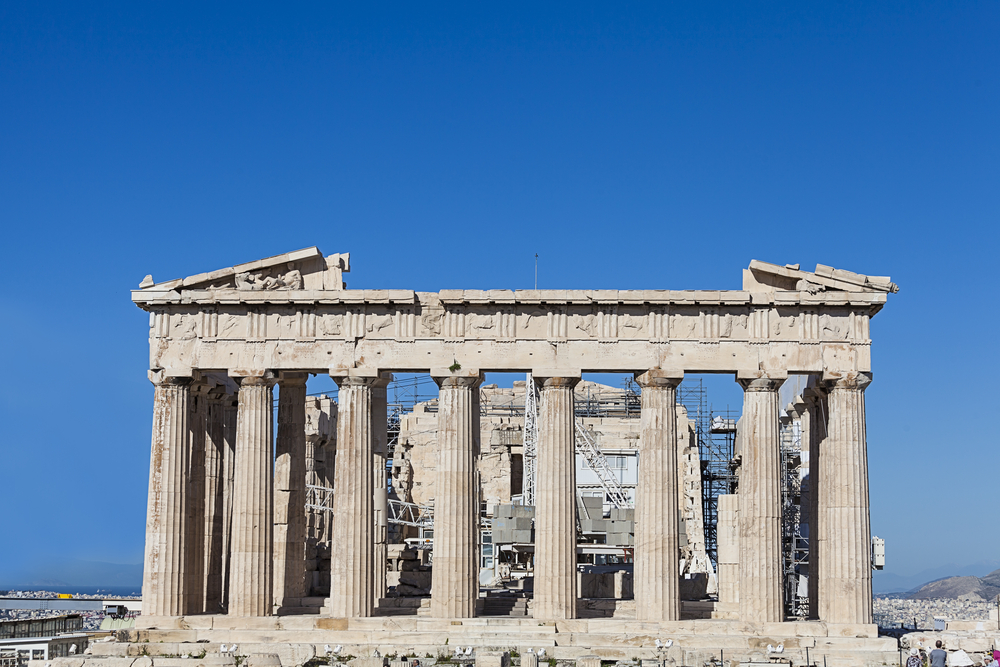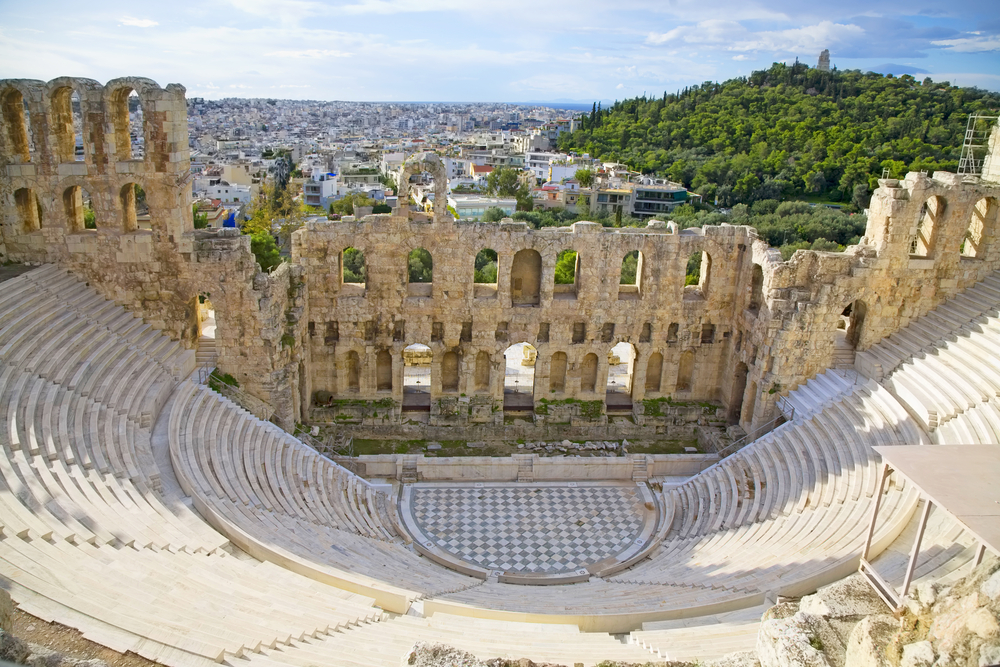Acropolis: 'High City' of Athens
Situated in the center of ancient Athens, the Acropolis is a hill containing ancient monuments and fortifications.
At its extreme points, it is 270 meters (885 feet) long and about 156 meters (512 feet) wide, writes University of Oregon researcher Jeffrey Hurwit in his book, "The Acropolis in the Age of Pericles" (Cambridge University Press, 2004). He notes that although it is not the highest hill in Athens, its natural defenses, access to water and a summit that you can build on made the ancient Athenians decide to build some of their greatest monuments on top of it.
There are different translations of its name, but the word Acropolis basically means “high city.”
“Almost every Greek city-state (or polis) had one, but no other acropolis was as successful as the Athenian,” Hurwit writes. The structure was always visible and “at various times throughout its uninterrupted 6,000 year-long cultural history served as dwelling place, fortress, sanctuary and symbol – often all at once.”
Early history
Hurwit notes in another book, "The Athenian Acropolis" (Cambridge University Press, 1999) that evidence for a human presence at the Acropolis goes back at least 6,000 years with a seven-inch (13.9 centimeters) statue of a “full-figured woman,” dating from that time, found near the Acropolis.
About 3,200 years ago, large structures were built on the Acropolis including what appears to be a palace (of which very little survives) and a series of “cyclopean” walls, so named because a myth emerged in later time periods that the walls had been built by mythical creatures called Cyclops.
Get the world’s most fascinating discoveries delivered straight to your inbox.
Hurwit notes that these walls extended for about 2,500 feet (760 meters), were up to 33 feet (10 meters) high and up to 20 feet (6 meters) thick. These walls, which were back-filled with earth to form a flat terrace, “did not so much shield and hide the royal compound inside as lift it high above the level of any attack,” he writes. These walls would remain standing for centuries and remains of them can still be seen on the Acropolis today. The civilization that built the palace and fortifications, today referred to as “Mycenaean” by archaeologists, fell into decline after 3,200 years ago, falling victim to a period of instability across the eastern Mediterranean world.
It would be 600 years before the next great building project on the Acropolis began.
The first sanctuary
The transformation of the Acropolis into a sizable religious sanctuary would begin in earnest during the sixth century B.C., nearly 600 years after the sizable Mycenaean fortifications were built. In this century, the “Hekatompedon,” a sizable temple, was built. It was 135 feet (41 meters) long, Hurwit writes, and little remains of the structure today.
Other features of the new construction included a ramp leading up to the Acropolis entranceway and the presence of an olive wood statue of Athena, housed in a temple of its own. “It was so old that the Athenians believed it had fallen from heaven,” writes Brooklyn College researcher Rachel Kousser in a 2009 journal article.
In the fifth century B.C., work would begin on another building known to us as the “old Parthenon”; however, before it was finished Athens would be sacked.
Last stand – sacked by Persians
In 480 B.C., war broke out against the Persians, again. An invasion attempt a decade earlier had been foiled at the Battle of Marathon and the Persians, led by king Xerxes, tried again.
As a massive army marched into northeastern Greece, Athens, Sparta and a number of smaller states decided to unite together to face the common threat. The venture did not start off well, with a defeat at the Battle of Thermopylae (where a Spartan force of 300 was annihilated by a Persian force many times its size). The Persians made their way to Athens, whose leaders decided to abandon the city, leaving the remaining defenders to make a stand of their own, this time on the barricaded Acropolis.
The Persians “wrapped arrows in tar and set them on fire, and then shot them at the barricade. Still the besieged Athenians defended themselves, although they had come to the utmost danger and their barricade had failed them,” writes the ancient historian Herodotus.
“When the Pisistratids [Persians] proposed terms of surrender, they would not listen but contrived defenses such as rolling down boulders onto the barbarians when they came near the gates.”
The Persians managed to flank the Athenian defenders by scaling an unprotected cliff. “When the Athenians saw that they had ascended to the acropolis, some threw themselves off the wall and were killed, and others fled into the chamber. The Persians who had come up first turned to the gates, opened them, and murdered the suppliants. When they had levelled everything, they plundered the sacred precinct and set fire to the entire acropolis.” (Translation by A.D. Godley, through Perseus Digital Library)
Although the Greeks soon turned the tide of war, winning a key naval victory at Salamis and eventually driving out the Persians, the Acropolis had been sacked and it would remain untouched for nearly 30 years, a war memorial of sorts.
The building program of Pericles
In the decades after Persia’s defeat, Athens would enter what many consider to be its “golden age.” It formed a naval alliance (eventually more like an empire) tasked with fighting Persia in the Aegean and east Mediterranean. This alliance resulted in tribute pouring into the city.
With Athens fortunes on the rise, a statesman named Pericles proposed that the city engage in an ambitious building project on the Acropolis, which had been kept in ruins after the Persian sacking.
Among the buildings that would be constructed was the Propylaea (a new entrance building), a sanctuary to Athena Nike, a temple called the Erechtheion and of course, the Parthenon, an iconic temple dedicated to Athena, whose name means “the house [or temple] of the virgin goddess.”
The costs were high. “These buildings alone cost easily more than the equivalent of a billion dollars in modern terms, a phenomenal amount for an ancient Greek city-state,” writes College of the Holy Cross professor Thomas Martin, in his book "Ancient Greece: From Prehistoric to Hellenistic Times" (Yale Nota Bene, 2000).
Propylaea and Sanctuary of Athena Nike
The Propylaea is a gateway, never completed, which was built for visitors ascending the entrance ramp to the Acropolis. Designed by an architect named Mnesikles, and containing northwest and southwest wings, it was constructed between 437 and 432 B.C. but never completed, Hurwit writes. Why the Propylaea was left uncompleted is a mystery, with financial, religious and aesthetic reasons given as possibilities.
Though it was unfinished, the Propylaea would have been used in antiquity. “[T]he southwest wing served as a waiting area and provided access to the [Athena] Nike sanctuary,” Hurwit writes. This sanctuary was a small square structure that had four slim Ionic columns on each side and an image of the goddess Athena Nike within it.
Hurwit also notes that, according to the ancient writer Pausania, the ceiling of the Propylaea was decorated with “gold or gilded stars against a blue background” and the northwest wing was filled with paintings, the collections including an “Achilles among the Virgins of Skyros” and an “Odysseus Surprising Nausikaa,” both works by a classical artist named Polygnotos.
Parthenon
The Parthenon, the largest building ever constructed on the Acropolis, measures 288 feet (69.5 meters) by 101 feet (30.9 meters) and stood about 65 feet (20 meters) high. Housing a gold and ivory statue of the goddess Athena, whom the temple was dedicated to, the structure was lavishly decorated in color.
It had 17 columns on its long sides and eight columns on its short ends. There were two pediments (triangular niches holding statues) towering above the short sides of the temple. The sculptures on the east pediment telling the tale of the birth of Athena and those on the west show a battle between Athena and Poseidon to determine who would be the patron god of Athens.
In addition, the Parthenon had 92 metopes carved in high relief showing scenes from Greek mythology. They were perched high atop the building, surrounding it on all four sides. Each side has a different battle, “beginning with the east or main entrance of the temple, Olympian gods fight earthborn giants for supremacy of Mount Olympos,” writes researcher Katherine Schwab in the book "The Parthenon" (Cambridge University Press, 2005). In the south, the metopes show a fight between Lapiths (a legendary people) and centaurs, while to the west they depict Amazons (women warriors) fighting Greek soldiers. Meanwhile the “fourth battle, in the north metopes, illustrates the Sack of Troy.”
In addition, a frieze, carved in low relief, wraps around the Parthenon for 524 feet (160 meters). While it’s hard to see on ground level, it depicts a procession that includes chariots racing, men on horses, young women carrying ritual items, cows to be sacrificed and depictions of gods including Dionysus, the god of wine and revelry, Demeter, goddess of the harvest, and Zeus, seated on his throne.
Erechtheion
The Erechtheion was an asymmetrical complex, started in 421 B.C., that honored multiple deities. Part of the building was supported with long slender Ionic columns while another section, shaped like a porch, was supported by shorter columns in the shape of six female figures known as “caryatids.”
Boston University professor Fred Kleiner notes that the structure contained a wooden statue of Athena while another section, supported by the caryatid pillars, held a spot where the mark of Poseidon’s trident was said to have been made.
All in all it “incorporated shrines to a host of other gods and demigods who loomed large in the city’s legendary past,” Kleiner writes in "Gardner’s Art Through the Ages: The Western Perspective" (Cengage Learning, 2010) “Among these were Erechtheus, an early king of Athens, during whose reign the wooden idol of Athena were said to have fallen from the heavens,” he writes. Another section was a tomb for “Kekrops, another king of Athens, who served as judge of the contest between Athena and Poseidon.”
Theater and Odeons
Although not technically part of the Acropolis, a number of structures were built on the southern slope of the Acropolis. Among them was a theater of Dionysus, shaped like an orchestra, which dates back to as early as the sixth century B.C. Later Pericles, the statesman, constructed a roofed Odeon beside it (now largely destroyed) where, according to the ancient writer Plutarch, Pericles held musical contests.
Pericles got “a decree passed that a musical contest be held as part of the Panathenaic festival. He himself was elected manager, and prescribed how the contestants must blow the flute, or sing, or pluck the zither [a string instrument]. These musical contests were witnessed, both then and thereafter, in the Odeum,” (From Plutarch’s "Parallel Lives")
Ruin and restoration
The passage of time was not kind to the Acropolis. With the spread of Christianity in Greece, the Parthenon would eventually be turned into a church and many of its metopes would be defaced. But perhaps the worst event in the history of the Acropolis occurred in 1687 during a siege of Athens by a Venetian force.
At the time, the city was controlled by the Ottoman Empire, whose military forces used the Parthenon as a gunpowder store. The structure was hit during the battle and an explosion devastated the Parthenon, leaving it in ruins.
At the beginning of the 19th century, Lord Elgin would remove many sculptures from the Parthenon, a controversial act that has led to a modern-day repatriation battle between the United Kingdom and Greece. The 20th century also posed problems for the monuments as the growth of Athens, and the adaption of the automobile, resulted in an increase in air pollution.
Today, in the 21st century, a new group of people is making a mark on the Acropolis. Conservators, engineers, architects and other scientists are working together at conserving and restoring the structures on it, part of a project that has been going on for 35 years.
“The restoration has clothed the monuments in scaffolding and filled the terraces of the sacred rock with temporary workshops and offices,” writes British Museum curator Ian Jenkins in the book "Acropolis Restored" (British Museum, 2012).
Jenkins notes that some of these people have been laid off or forced to retire due to the financial problems Greece is experiencing. “The honour that they have earned and the benefit of their work to the monuments and generations of visitors to come can never be diminished. Their legacy will endure.”
— Owen Jarus, LiveScience Contributor

Owen Jarus is a regular contributor to Live Science who writes about archaeology and humans' past. He has also written for The Independent (UK), The Canadian Press (CP) and The Associated Press (AP), among others. Owen has a bachelor of arts degree from the University of Toronto and a journalism degree from Ryerson University.





